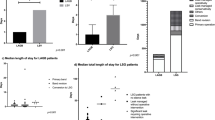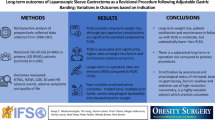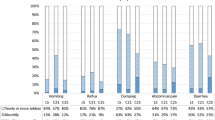Abstract
Background
Patient-reported outcomes and perceptions are critical to the overall efficacy and acceptability of a surgical procedure. Outcomes, such as patient satisfaction and perceived success of the surgery and adverse symptoms, have not been described in detail following bariatric surgery. The associations and predictors of patient satisfaction have not been defined. This study aimed to examine long-term outcomes and perceptions after laparoscopic adjustable gastric banding (LAGB).
Methods
We conducted a prospective study of outcomes, satiety and adverse upper gastrointestinal symptoms, as well as quality of life and subjective patient satisfaction in LAGB patients. Data were collected at 3 years (T1) and 8 years post-operatively (T2).
Results
One-hundred and sixty patients completed follow-up at T1 and T2. The average age was 44.0 ± 11.2 years. At T2, the total body weight loss was 17.8 ± 11.9 %. Satisfaction decreased significantly between time points (8.6 ± 1.8 vs 7.2 ± 2.9, p < 0.01), and quality of life reduced slightly across all domains. Hunger scores remained low (3.8 ± 1.8 vs 3.9 ± 1.8, p = 0.61). The dysphagia score did not change significantly (p = 0.54). There was minimal change in frequency of regurgitation, although there was significant increase in patient assessment of how bothered they were by regurgitation. Multivariate analysis identified increased awareness of regurgitation as a principal driver of reduced satisfaction.
Conclusions
Weight loss, satiety and adverse symptoms demonstrated only slight changes between 3 and 8 years post-operatively. Despite this, overall satisfaction and perception of success of the procedure reduced markedly. This appeared mediated by reduced tolerance of adverse symptoms. These data inform follow-up practises aimed at optimizing outcomes.




Similar content being viewed by others
References
O’Brien PE, MacDonald L, Anderson M, et al. Long-term outcomes after bariatric surgery: fifteen-year follow-up of adjustable gastric banding and a systematic review of the bariatric surgical literature. Ann Surg. 2013;257(1):87–94.
Courcoulas AP, Yanovski SZ, Bonds D, et al. Long-term outcomes of bariatric surgery: a National Institutes of Health symposium. JAMA Surg. 2014;149(12):1323–9.
Mauro M, Taylor V, Wharton S, et al. Barriers to obesity treatment. Eur J Intern Med. 2008;19(3):173–80.
Vishne TH, Ramadan E, Alper D, et al. Long-term follow-up and factors influencing success of silastic ring vertical gastroplasty. Dig Surg. 2004;21(2):134–40.
Burton PR, Brown W, Laurie C, et al. Outcomes, satiety, and adverse upper gastrointestinal symptoms following laparoscopic adjustable gastric banding. Obes Surg. 2011;21(5):574–81.
O’Brien P. The lap-band™ solution: a partnership for weight loss. Carlton, Victoria: Melbourne University Publishing; 2010.
Anvari M, Allen C, Borm A. Laparoscopic Nissen fundoplication is a satisfactory alternative to long-term omeprazole therapy. Br J Surg. 1995;82(7):938–42.
Dakkak M, Bennett JR. A new dysphagia score with objective validation. J Clin Gastroenterol. 1992;14(2):99–100.
Grande ED, Taylor A (2004) Quality of life in South Australia as measured by the SF-36: population norms for 2002, trends from 1994 to 2002 and impact of chronic diseases and health risk factors on quality of life: population research and outcomes unit. South Australia: Department of Human Services
Puzziferri N, Roshek 3rd TB, Mayo HG, et al. Long-term follow-up after bariatric surgery: a systematic review. JAMA. 2014;312:934–42.
Conceicao E, Mitchell JE, Vaz AR, et al. The presence of maladaptive eating behaviors after bariatric surgery in a cross sectional study: importance of picking or nibbling on weight regain. Eat Behav. 2014;15(4):558–62.
Brandao I, Ramalho S, Pinto-Bastos A, et al. Metabolic profile and psychological variables after bariatric surgery: association with weight outcomes. Eat Weight Disord. 2015;20(4):513–8.
Odom J, Zalesin KC, Washington TL, et al. Behavioral predictors of weight regain after bariatric surgery. Obes Surg. 2010;20(3):349–56.
Mahony D. Bariatric surgery attrition secondary to psychological barriers. Clin Obes. 2013;3(1–2):32–8.
Funk LM, Jolles S, Fischer LE, et al. Patient and referring practitioner characteristics associated with the likelihood of undergoing bariatric surgery: a systematic review. JAMA Surg. 2015;150(10):999–1005.
Author information
Authors and Affiliations
Corresponding author
Ethics declarations
Disclosures
The Centre for Obesity Research and Education has received research support from Allergan and Apollo Endosurgery, Inc. and Apollo Endosurgery, the manufacturers of the LAP-BAND.
Wendy Brown declared that her research group (Centre for Obesity Research and Education) receives funding from the manufacturer of the LapBand™ (Allergan and Apollo Endosurgery) as well as from Applied Medical. She has received an honorarium from Merck Sharp and Dohme for lectures and Novo Nordisc for participation on a Scientific Advisory Panel. She has also received funding for a Bariatric Surgery Registry from the Commonwealth of Australia, Johnson and Johnson, Covidien/Medtronic, GORE, Applied Medical, Apollo Endosurgery and Allergan.
Paul Burton and Geraldine Ooi have received funding from the National Health and Medical Research Council (NHMRC) and the Royal Australasian College of Surgeons.
Conflicts of Interest
The authors declare that they have no conflicts of interest.
Rights and permissions
About this article
Cite this article
Burton, P.R., Ooi, G.J., Laurie, C. et al. Changes in Outcomes, Satiety and Adverse Upper Gastrointestinal Symptoms Following Laparoscopic Adjustable Gastric Banding. OBES SURG 27, 1240–1249 (2017). https://doi.org/10.1007/s11695-016-2434-3
Published:
Issue Date:
DOI: https://doi.org/10.1007/s11695-016-2434-3




